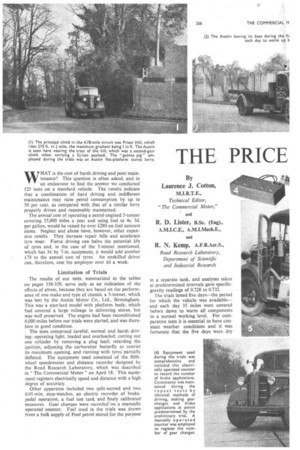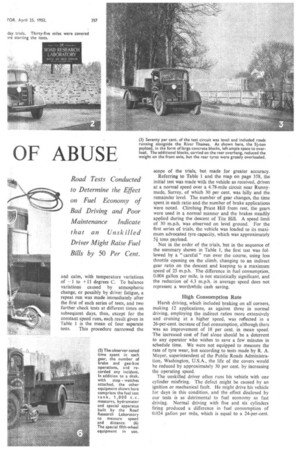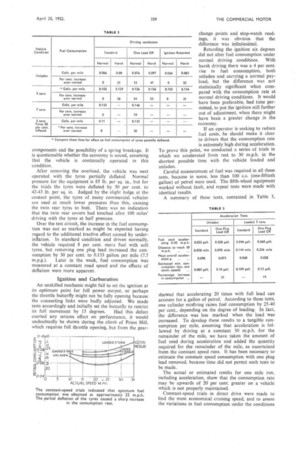THE PRICE OF ABUSE
Page 110

Page 111

Page 112

Page 113

Page 114

If you've noticed an error in this article please click here to report it so we can fix it.
By Laurence J. Cotton,
WHAT is the cost of harsh driving and poor maintenance? This question is often asked, and in an endeavour to find the answer we conducted 125 tests on a standard vehicle. The results indicate that a combination of hard driving and indifferent maintenance may raise petrol consumption by up to 50 per cent. as compared with that of a similar lorry properly driven and reasonably maintained.
The annual cost of operating a petrol-engined 5-tonner covering 25,000 miles a year and using fuel at 4s. 3d. per gallon, would be raised by over £280 on fuel account alone. Neglect and abuse have, however, other expensive results. They increase repair bills and accelerate tyre wear. Fierce driving can halve the potential life of tyres and, in the case of the 5-tonner mentioned, which has 34 by 7-in, equipment, it would add another £78 to the annual cost of tyres. An unskilled driver can, therefore, cost his employer over £6 a week.
Limitation of Trials
The results of our tests, summarized in the tables on pages 358-359, serve only as an indication of the effects of abuse, because they are based on the performance of one make and type of chassis, a 5-tonner, which was lent by the Austin Motor Co., Ltd., Birmingham. This was a standard model with platform body, which had covered a large mileage in delivering stores, but was well preserved. The engine had been reconditioned 6,000 miles before our trials were started, and was therefore in good condition.
The tests comprised careful, normal and harsh driving; operating light, loaded and overloaded; cutting out one cylinder by removing a plug lead; retarding the ignition, adjusting the carburetter butterfly to restrict its maximum opening, and running with tyres partially deflated. The equipment used consisted of the fifthwheel speedometer and distance recorder designed by the Road Research Laboratory, which was described in 'The Commercial Motor" on April 18. This equipment registers electrically speed and distance with a high degree of accuracy.
Other apparatus included two split-second and two 0.01-min. stop-watches, an electric recorder of brakepedal operation, a fuel test tank and finely calibrated measures. Gear changes were recordecron a manually operated counter. Fuel used in the trials was drawn from a bulk supply of Pool petrol stored for the purpose in a separate tank, and analyses taken at predetermined intervals gave specificgravity readings of 0.728 to 0.732. The trials tasted five days—the period for which the vehicle was available— and each day 35 miles were covered before dawn to warm all components to a normal working level. For comparative tests it is essential to have constant weather conditions and it was fortunate that the five days were dry and calm, with temperature variations of 1 to + 11 degrees C. To balance variations caused by atmospheric change, or possibly by driver fatigue, a repeat run was made immediately after the first of each series of tests, and two further check tests at different times on subsequent days, thus, except for the constant speed runs, each result given in Table 1 is the mean of four separate tests. This procedure narrowed the scope of the trials, but made for greater accuracy.
Referring to Table 1 and the map on page 358, the initial test was made with the vehicle as received, driven at a normal speed over a 4.78-mile circuit near Runnymede, Surrey, of which 30 per cent, was hilly and the remainder level. The number of gear changes, the time spent in each ratio and the number of brake applications were noted. Climbing Priest Hill from rest, the gears were used in a normal manner and the brakes steadily applied during the descent of Tite Hill. A speed limit of 30 m.p.h. was observed on level ground. For the first series of trials, the vehicle was loaded to its maximum advocated tyre capacity, which was approximately 5i tons payload.
Not in the order of the trials, but in the sequence of the summary shown in Table 1, the first test was followed by a "careful " run over the course, using less throttle opening on the climb, changing to an indirect gear ratio on the descent and keeping to a maximum speed of 25 m.p.h. The difference in fuel consumption, 0.004 gallon per mile, is not statistically significant, and the reduction of 4.3 m.p.h. in average speed does not represent a worthwhile cash saving.
High Consumption Rate
Harsh driving, which included braking on all corners, making 12 applications, as against three in normal driving, employing the indirect ratios more extensively and cruising at a higher speed, was reflected in a 26-per-cent. increase of fuel consumption, although there was an improvement of 18 per cent. in mean speed. The increased cost of fuel alone should be a deterrent to any operator who wishes to save a few minutes in schedule time. We were not equipped to measure the rate of tyre wear, but according to tests made by R. A. Moyer, superintendent of the Public Roads Administration, Washington, U.S.A., the life of the covers would be reduced by approximately 30 per cent. by increasing the operating speed.
The unskilled driver often runs his vehicle with one cylinder misfiring. The defect might be caused by an ignition or mechanical fault. He might drive his vehicle for days in this condition, and the effect disclosed by our tests is as detrimental to fuel economy as fast driving. Normal driving with five and six cylinders firing produced a difference in fuel consumption of 0.024 gallon per mile, which is equal to a 24-per-cent. increase. In addition, the average speed was impaired with one cylinder misfiring.
Fierce driving coupled with misfiring makes for 53 per cent. greater fuel consumption than if the vehicle were driven in a normal manner with all cylinders firing evenly. Fleet operators employing similar vehicles over a given route would discover such abuse from the fuel records, but in the majority of cases a bad driver escapes detection because of the diversity of routes and loads, inadequate records or poor supervision. Apart from the s'econd test (driving the vehicle, in standard condition, with care) all the trials were conducted again without load. Journey times were shortened and fewer gear changes were made, because Priest Hill was climbed comfortably in direct drive, but there were additional brake applications in negotiating the top bend.
Indifferent Maintenance Bad driving again brought to light a marked increase in fuel consumption, the results, which are summarized in Table 2, indicating that mare petrol would be used by mishandling a well-maintained unladen vehicle than by driving well with one cylinder misfiring. There was again almost a 50-per-cent. increase in consumption. As a point of interest, the properly maintained, welldriven vehicle, carrying a 5i-ton payload, uses practically the same amount of fuel per mile as a badly driven unladen lorry which is misfiring on one cylinder.
Some operators condone overloading, often to a serious degree. We put seven concrete blocks, each weighing approximately a ton, on the Austin, merely to find out how this load affected its performance. Obviously, the mechanical disadvantages of such a practice could not be assessed during our tests, but many parts would be affected, such as the rear axle, which supported over 8 tons. This meant that, provided that the load was equally distributed, neglecting camber and profile of the road, each rear tyre carried 41 cwt., which represents a 49-per-cent. overload according to home standards and 71 per cent. when assessed on the overseas ratings. Such loading is not uncommon.
Tests were made with this load, but under the conditions prevailing on the test course, it was not practicable to reproduce the effects of harsh driving. The addition of 2 tons over the advocated payload naturally caused an increase in fuel consumption. This was not in direct proportion to payload but nearly in proportion to the gross loads. The consumption rose by 20 per cent. to 0.123 gallon per mile (8.1 m.p.g.) with the vehicle in standard condition and to 0.146 gallon per mile (6.85 m.p.g.) with the plug lead removed.
In terms of fuel consumption per payload-ton-mile, it is cheaper to operate with an overload, but at the risk of a tyre burst, increased wear on the chassis components and the possibility of a spring breakage. It is questionable whether the economy is sound, assuming that the vehicle is continually operated in this condition.
After removing the overload, the vehicle was next operated with the tyres partially deflated. Normal pressure for the equipment is 85 lb. per sq. in., but for the trials the tyres were deflated by 50 per cent. to 42-43 lb. per sq. in. Judged by the slight bulge at the contact point, the tyres of many commercial vehicles are used at much lower pressures than this, causing the twin rear tyres to butt. There was no indication that the twin rear covers had touched after 100 miles' driving with the tyres at half pressure.
Over the test circuit, the increase in the fuel consumption was not as marked as might be expected having regard to the additional tractive effort caused by underinflation. In standard condition and driven normally, the vehicle required 8 per cent. more fuel with soft tyres, but removing one plug lead increased the consumption by 30 per cent. to 0.133 gallon per mile (7.5 m.p.g.). Later in the week, fuel consumption was measured at a constant road speed and the effects of deflation were more apparent.
Ignition and Carburation An unskilled mechanic might fail to set the ignition at its optimum point for full power output, or perhaps the throttle butterfly might not be fully opening because the connecting links were badly adjusted. We made tests accordingly and initially set the butterfly to restrict its full movement by 15 degrees. Had this defect exerted any serious effect on performance, it would undoubtedly be shown during the climb of Priest Hill, which requires full throttle opening, but from the gear change points and stop-watch readings, it was obvious that the difference was infinitesimal.
Retarding the ignition six degrees did not alter fuel consumption under normal driving conditions. With harsh driving there was a 4 per cent. rise• in fuel consumption, both unladen and carrying a normal payload, but the difference was not statistically significant when compared with the consumption rate at normal driving conditions. It would have been preferable, had time permitted, to put the ignition still further out of adjustment, when there might have been a greater change in the economy.
If an operator is seeking to reduce fuel costs, he should make it clear to drivers that the consumption rate is extremely high during acceleration. To prove this point, we conducted a series of trials in which we accelerated from rest to 30 m.p.h. in the shortest possible time with the vehicle loaded and unladen.
Careful measurement of fuel was required in all these tests, because in some, less than 100 c.c. (one-fiftieth gallon) of petrol were used. The fifth-wheel equipment worked without fault, and repeat tests were made with identical results.
A summary of these tests, contained in Table 3,
— —
showed that accelerating 20 times with full load can account for a gallon of petrol. According to these tests, one cylinder misfiring raises fuel consumption by 25-40 per cent., depending on the degree of loading. In fact, the difference was less marked when the load was increased. To develop these results to a tangible consumption per mile, assuming that acceleration is followed by driving at a constant 30 m.p.h. for the remainder of the mile, we have taken the amount of fuel used during acceleration and added the quantity required for the remainder of the mile, as ascertained from the constant speed runs. It has been necessary to estimate the constant speed consumption with one plug lead removed, because time did not permit such tests to be made.
The actual or estimated results for one mile run, including acceleration, show that the consumption rate may be upwards of 20 per cent. greater on a vehicle which is not properly maintained.
Constant-speed trials in direct drive were made to find the most economical cruising speed, and to assess the variations in fuel consumption under the conditions of the previous trials. The results shown in the accompanying graph indicate a minimum consumption for all load conditions at 22 m.p.h. An increase in speed over the optimum caused heavier fuel consumption.
The constant-speed fuel curves indicate the performance of vehicles on long-distance haulage in level areas. Without load, the guinea-pig vehicle required 0.0575 gallon per mile (17.4 m.p.g.) at optimum speed, Travelling at 30 m.p.h., 7i per cent. more fuel (16.1 m.p.g.) was needed, and at 35 m.p.h. the consumption was raised by 25 per cent. (13.9 m.p.g.).
The difference when carrying a load was not so marked, 0.068 gallon per mile (14.7 m.p.g.) being used at 22 m.p.h. and 7 per cent, more fuel (13.7 m.p.g.) at 30 m.p.h. Only 15 per cent, increase in fuel consumption was noted at 35 m.p.h. This corresponds to 12.8 m.p.g. During these tests the partially inflated tyres caused heavy traction loss. Long-distance hauliers and coach operators should, in particular, note the additional cost in fuel, apart from internal danger to tyres incurred by under-inflation. The degree by which fuel consumption is affected when insufficient attention is paid to tyre pressures was shown by a 16 per cent. increase at 30 m.p.h. when carrying a 5-ton load.
In the time for which the vehicle was available, account could not be taken of other malpractices in driving and maintenance. Fleet operators may, however, wish to conduct experiments of their own.
Misuse or neglect will, over a period, be shown in the rate of tyre and engine wear. An operator cited the case of two of his employees driving similar vehicles, one of which required an engine overhaul after 20,000 miles, and a tyre change at 18,000 miles. The second vehicle, which performed precisely the same amount of work, was driven by an older employee, and its engine lasted 54,000 miles and the tyres 58,000 miles, Had adequate vehicle records been maintained, the operator would have detected the bad driving at an earlier stage.




























































































































































































































